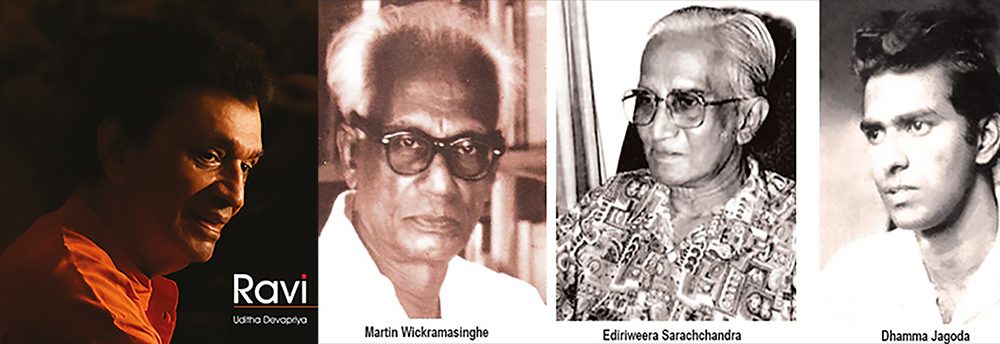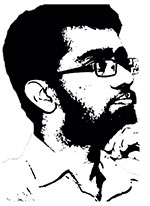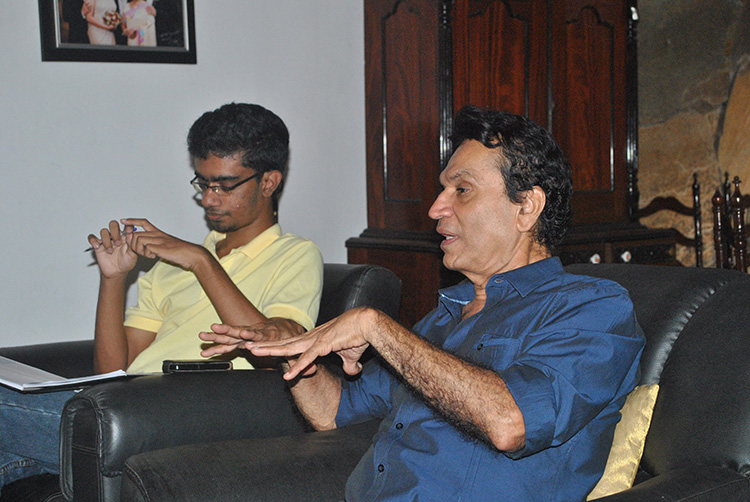Features
Deconstructing Ravi

By Uditha Devapriya

Weragama’s book was published by Sarasavi, mine by FastADS. Both were launched at a ceremony at the BMICH last Wednesday, June 5. The event, excellently put together by a hardworking, passionate team led by Dr Ranga Kalansooriya, witnessed a galaxy of actors, directors, critics, writers, MPs, even the president and prime minister. My friend Indunil put it in perspective: “the whole of Sinhala cinema was there that night.”
Ravindra is Ravi aiya to his colleagues, contemporaries, and juniors. He is by far the most distinguished, reputable actor alive in Sri Lanka. This is not to underplay or ignore any criticism we can make of him. Yet, as far as Sri Lankan actors go, he remains unmatched in the dazzling range and complexity he has embraced in role after role.
But there is more to Ravindra than the films he has been in and the roles he has taken on. Much more. To assess his career more carefully, I believe we need to look at him through a different lens and prism, specifically a sociohistorical one. This is the perspective I have adopted in parts of my book, but it is one which requires a radically different conception of actors and their place in our society.
Any assessment of Randeniya must, I think, begin from the fact that he came of age in 1956. That year has become pivotal for reasons which warrant a separate essay. More than anything, it launched the careers of an entirely different generation of artistes, including playwrights, filmmakers, musicians, and dancers.
While S. W. R. D. Bandaranaike was spreading the gospel of Sinhala Only throughout the country, Ravindra Randeniya was taking part in a Fifth Standard production of Sigiri Kashyapa at his school, St Benedict’s College, Kotahena. Incredibly, it was the only stage production he took part in at school. Indeed, he would not act in any production of any sort until more than a decade later, when he joined the Lionel Wendt Theatre Workshop. Why so? Because, in his own words, “I was more interested in literature than in theatre.”
A highly literate student, Ravindra immersed himself in the literature of his time, reading everyone from Martin Wickramasinghe to Siri Gunasinghe to Gunadasa Amarasekara to Mahagama Sekara. Though he watched films, he did so only occasionally, and was limited to standard Hollywood and Bollywood fare. Over time, he saw himself as a litterateur, though his larger ambition was to become a doctor.
For better or worse, Ravindra could not pursue his medical ambitions. He then got down to working for his father. By now, he was living through a completely different time. The Sinhala theatre was undergoing a revival, as was the cinema. Spurred on by the likes of Ediriweera Sarachchandra and Lester Peries, these mediums became more accessible to the Sinhala speaking masses, leading to the formation of independent theatre collectives which went against the grain and questioned accepted artistic conventions.
Ravindra’s entry into the cinema was preceded by three long but fateful years at the Lionel Wendt Theatre Workshop. The Workshop was a product of its time, and its impact on the country’s cultural community was considerable. However, for some reason, it has escaped the attention of critics. To understand its relevance for Ravindra, we ought to delve into the changes that were sweeping through Sri Lanka at that point.
In the 1950s and 1960s, a number of playwrights and theatre practitioners made their way to Western countries, through grants and scholarships. One of the first of these was Henry Jayasena, who travelled to both Russia and England. Gunasena Galappatti, who introduced García Lorca to Sri Lankan audiences, won a Fulbright Scholarship to the US, where he came under the influence of Uta Hagen and the Actors’ Studio. This was around the time that two other pioneering intellectuals – Gananath Obeyesekere and J. B. Disanayake – secured the Fulbright. The impact of these scholarships and exchange programmes on Sri Lanka’s cultural trajectory was massive, though it has never been researched in full.
Freed from the conventions of their predecessors, these dramatists experimented in different artistic forms and idioms. They fostered the growth of a bilingual cultural elite in Sri Lanka. They also attracted another group of playwrights, who hailed from a Sinhala-speaking lower middle-class and had found jobs in the country’s administrative service. Many among this group went on to form independent theatre collectives, the most popular of which was Sugathapala de Silva’s Ape Kattiya, along with Premaranjith Tillekeratne’s 63 Kandayama – a breakaway faction from Ape Kattiya – and G. D. L. Perera’s Kala Pela.
These playwrights were driven by an almost visceral aversion to Sarachchandra’s mixture of stylised and realist theatre. Premaranjith, in particular, took a strong dislike to what he saw as the great man’s opposition to Western theatrical forms. “When I once played for him a recording from West Side Story,” he related to me, “he just winced and said, ‘What is this cacophony?’” Such encounters persuaded Tillekeratne and his peers that the country was in need of a different conception of theatre and art.
Of course, to limit the Lionel Wendt Theatre Workshop to the efforts of these innovators alone would be to credit one group, when there was in fact several other groups involved in its establishment and founding. Sarachchandra himself became a founding figure, as did scholars like Percy Colin-Thomé, A. J. Gunawardena, and Wimal Dissanayake, together with artistes from other fields, like Chitrasena, Manjusri, and Amaradeva.
Looming above all of them was Dhamma Jagoda. A dramatist, connoisseur of the arts, and fiery radical, Jagoda was instrumental in formulating a syllabus for the Workshop. Together with Harold Peiris, he came up with a curriculum which could impart the best and the latest in Western, European, and Asian theatre to students.
Jagoda himself had travelled abroad on a grant. In 1967-1968, following his production of Tennessee Williams’s A Streetcar Named Desire – Sinhalised as Ves Muhunu and starring the likes of Roma de Zoysa, Rukmani Devi, and Sunethra Sarachchandra – he had secured a scholarship from the British Council. Visiting more than 15 countries, and ending up in New York, he had not just met Lee Strasberg but also talked with Marlon Brando.
Jagoda was tempestuous and unpredictable, a Picasso-like genius who resorted to the most unconventional methods. “He gave up everything to dedicate himself to teaching,” his wife Manel, who became involved in the Workshop, first as a student and then as an organiser, recalls. Ravindra’s senior by four years, he mentored the budding actor well. “He was an almost fanatical stickler for time,” Ravindra remembered him. “Once I got five minutes late, and he put me out, telling me that we should be five minutes early.”
If these anecdotes and encounters put Ravindra in the background, that is because Ravindra was a product of his times, and there is no use deconstructing him without deconstructing the period he hailed from. Moreover, Ravindra’s forays into the cinema were conditioned by his experience in the theatre, for at least two reasons.
First, the Workshop made him more receptive to the intricacies of acting: he had signed up originally for backstage work, among other subjects, but Dhamma pulled him into acting classes. “It made me more sensitive to the art of acting, which I had not seen as an art until then.” Second, because it involved the leading cultural figures of the day, the Workshop attracted the interest of filmmakers, actors, and critics. By 1972, when he passed out with a Diploma, Ravindra was hence getting offers from the likes of Lester Peries.
All these points have been laid bare in the two books on Ravindra. The man’s achievements cannot be emphasised enough. Ravindra redefined what it meant to be an actor in Sri Lanka. The stage had already been set for him by Gamini Fonseka, Joe Abeywickrema, and Tony Ranasinghe. Ravindra continued their legacy while breaking with their tradition: in effect, by cultivating a range almost unparalleled among his predecessors.
It is thus wrong to pigeonhole Ravindra into one type of role and to overlook his diversity. That diversity is what makes the man tick. The Lionel Wendt Theatre Workshop, and the developments of the 1960s, had a huge say on his evolution. It would be wrong to overlook those developments too. This is the point of our books.
Uditha Devapriya is a writer, researcher, and analyst who writes on topics such as history, art and culture, politics, and foreign policy. He is one of the two leads in U & U, an informal art and culture research collective. He can be reached at udakdev1@gmail.com.
